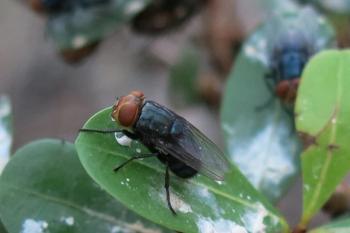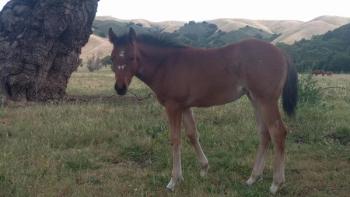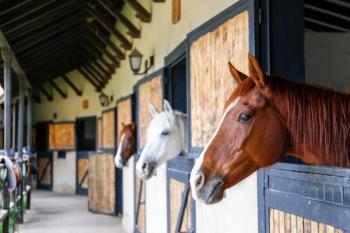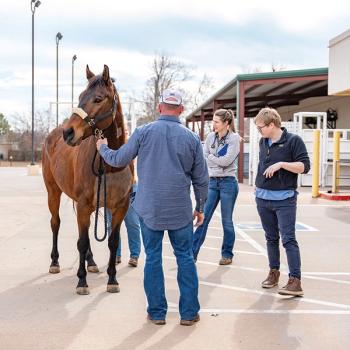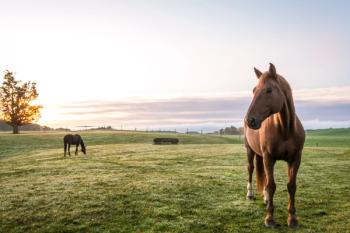
W.Va. studies practitioner need
State launches model survey to mine untapped equine industry; state has 'tremendous' equine practice potential
The state of West Virginia is willing to bet $50,000 it's been overlooked by the equine industry.
Until now, lack of convincing data that the industry in West Virginianot only exists, but is burgeoning has kept alive the status of states suchas Kentucky, Virginia and California as proverbial "horse country"frontrunners.
State leaders of West Virginia plan to erase all doubt upon completionof a state and privately funded $50K survey that will determine the horseindustry's economic influence and establish an accurate horse count, amongother agendas, within its borders.
The goal is to better manage the monies that the horse industry alreadycontributes to the state and to potentially advertise West Virginia to futureveterinary graduates, says Tom Walker, chair of the committee responsiblefor the survey.
State Senate Finance Chairman Oshel Craigo, a proponent of the initiative,put the study in motion. He says it will be launched in January and is expectedto take up to 18 months to complete.
"I would suggest (the equine industry) is a lot bigger than we realize,"he says.
The West Virginia University (WVU) College of Agriculture and ExtensionService is drafting the survey, the first since 1985, under the directionof Walker, an assistant professor at WVU.
Ingredients of survey
The survey will account for all equine breeds and the total number ofhorses in West Virginia, according to Walker. Officials are optimistic thesurvey, by showing the number of horses in the state, may prove the lackof equine veterinary hospitals.
"We have such a deficit of large animal practitioners that we hopethis study will help prove there is a need," says Walker. The statecurrently operates with 26 large animal practitioners and 90 mixed animalpractitioners, according to the West Virginia Board of Veterinary Medicine.
In addition, Walker says the survey, which targets horse owners, willhelp estimate the value of equine breeds in the state; determine use ofhorses; types of horse events; demographics such as income and educationlevel of horse owners; value of equine assets; and contributions to traditionalagriculture production of West Virginia (purchase of hay or wood shavings).
"The purpose of this study is to determine the present and futurepotential impact of the horse industry on economic development and tourism,"says Noah Perry, treasurer of the West Virginia Horse Council, who contributedinput for the survey.
The survey is being funded by in-kind contributions from the extensionservice and horse council and the veterinary medical association and others.
"We want to engender as much cooperation as we can to get a broadercross-section of data from throughout the industry," says Perry.
Horse industry missing
The agricultural commodity reports were a driving force behind the survey,says Walker.
"When you look at any ag commodity reports, the horse industry isnever listed. Horses traditionally have not been part of it, because they'vebeen geared toward recreational," he says.
"We feel there is a real need to prove that the horse industry playsa major impact on the traditional agriculture industry as well as the economy.When you look at it, horses are livestock, but they're never really lookedat as true agricultural livestock."
Aside from travel and tourism monies generated from horse events, accordingto Walker, a person who owns at least one horse or pony, for example, hasto buy hay and grain, which affects the state's traditional agricultureand economy.
Veterinary backing
Survey leaders are calling upon large animal, mixed and equine veterinariansto help contact their clientele to participate.
In the early stages of the project, officials are contacting equine associations,veterinarians, farriers, and industry groups to develop a solid mailinglist of horse owners, Walker says.
"The veterinarians could have a vested interest in helping us showthere's a need to really develop a strong hospital type facility that canservice the equine industry," he says.
He envisions the survey results being used by veterinarians as a marketingtool.
"I have some friends who are veterinarians. When they're expandingtheir practice, if they want to bring a specialist in, they have to showthere's a market for them. I hope this study can help them show we havethis number of horses in this geographic region that we can really service,"says Walker.
A veterinary bonus, according to Perry, is the potential to develop afuture equine veterinary diagnostic facility (a first for the state). Currently,horse owners must transport their horses out of state for most major surgeries,according to Perry.
"If we ever will be able to get it changed, it will be because thestudy will tell us it needs to change," he says.
Or one can ask a local veterinarian.
Bubble not bursting
Dr. James Henderson, a 21-year practitioner in Fairmont, a northern localein West Virginia, says his practice today is probably 80 to 90 percent equine.When he first went solo in 1989 his practice was about 50-50 horsesand cattle.
"Some of my cattle work has fell off due to the natural cycle ofthe beef industry. But the horse work has increased every year," saysHenderson, current secretary of the West Virginia Veterinary Medical Association.
His practice mirrors the equine industry he serves.
"(The growth) has caught people's attention. For the past five years,I've been waiting for the bubble to bust," he says.
One indicator of growth, says Henderson, is his increase in major surgeryreferrals to places out of state, since where he's located in West Virginiareferral centers are not to be found.
"It would not surprise me if at some point in the next five to 10years, somebody does build a fully-equipped and operational equine hospitalor surgical facility (in the area)," Henderson says.
Meanwhile, he says he's lucky he can handle most surgeries without referral.
"My office is my pickup. The way my practice goes, I'm like ol'doc on Gunsmoke. I can take care of about 99 percent of what you need done- routine vaccinations, minor surgeries, castrations, foalings. The restof it - colic surgery, broken bones, C-section-I can refer," says Henderson.
"A long time ago, I thought I'd build one of those (referral centers),but I realized that would be too much in the way of gray hair-making. Ilike my stomach the way it is without ulcers," he says.
DVM's testimony
Another veterinarian, Dr. Clara Mason, a solo mobile practitioner insouthwestern Winfield, W.Va., says she was asked to testify before the statelegislature in support of the equine survey.
"We have an extremely untapped horse industry," says Mason,who says she's counting on survey leaders to market the results to future,as well as relocating, veterinarians.
"The equine vets are overwhelmed," says Mason, "(because)there are very few of us."
Mason estimates up to nine counties are without a large animal practitioner."I personally cover 12 counties. I cannot tell you how many farm callsI turn down. I have people offer me the moon to drive three and a half hoursfor a $45 ultrasound."
Mason says she rarely sees a break in her calendar, treating 100 to 200horses per week on 60 to 80 appointments.
"I think the survey will make the state more attractive to equineand large animal veterinarians," she says.
Until then, she says, many will still turn up their noses at the thoughtof working in West Virginia.
"They have a pre-conceived notion of West Virginia, which sadlyis not really true. There's a tremendous horse industry here," saysMason.
Newsletter
From exam room tips to practice management insights, get trusted veterinary news delivered straight to your inbox—subscribe to dvm360.


